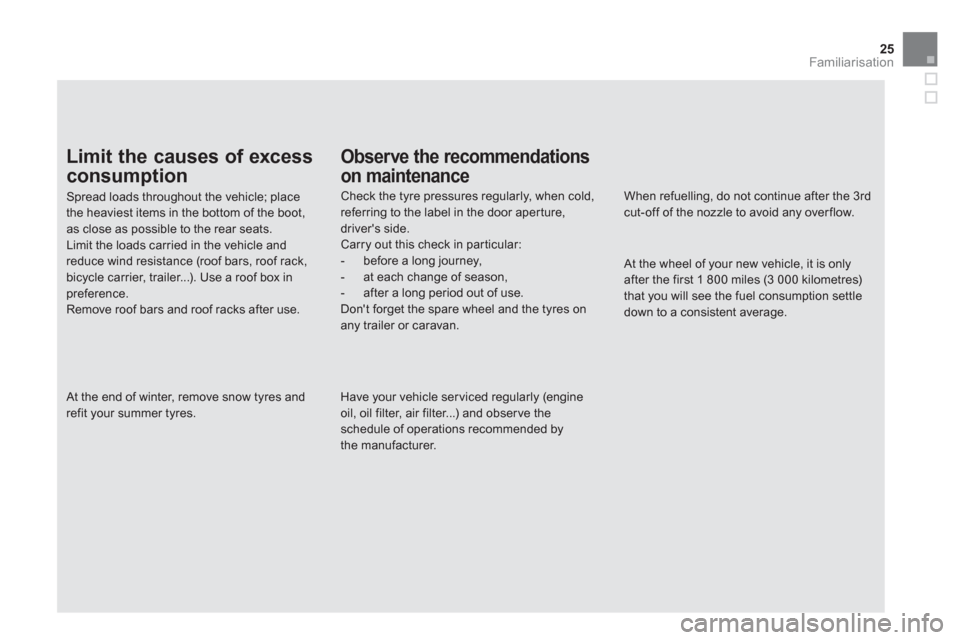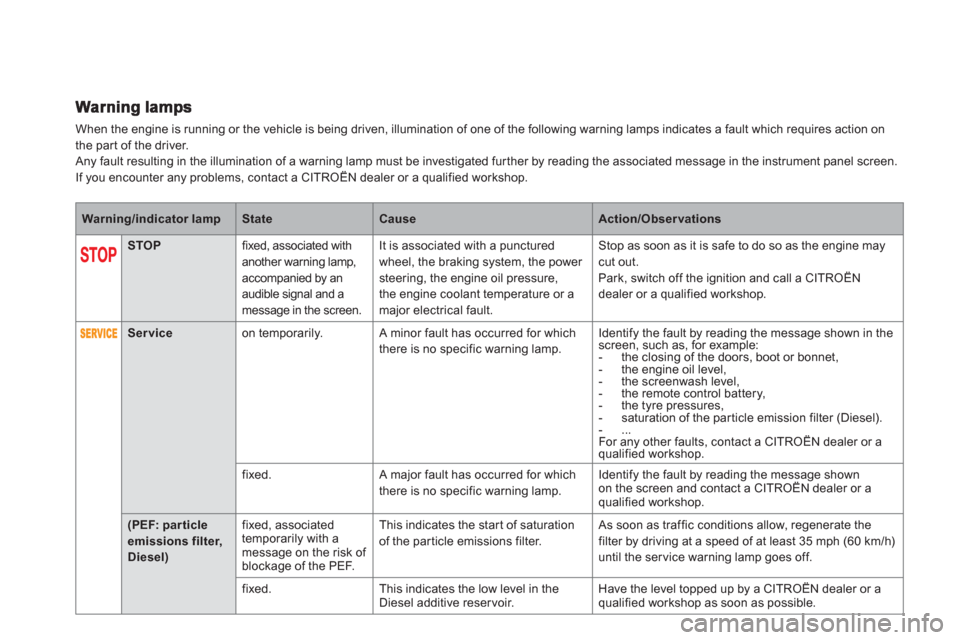2011 Citroen DS5 tyre pressure
[x] Cancel search: tyre pressurePage 27 of 348

25
Familiarisation
Limit the causes of excess
consumption
Spread loads throughout the vehicle; place the heaviest items in the bottom of the boot,as close as possible to the rear seats.Limit the loads carried in the vehicle and reduce wind resistance (roof bars, roof rack, bicycle carrier, trailer...). Use a roof box inpreference.Remove roof bars and roof racks after use.
At the end of winter, remove snow tyres and refit your summer tyres.
Observe the recommendations
on maintenance
Check the tyre pressures regularly, when cold, referring to the label in the door aper ture, driver's side.Carry out this check in par ticular:- before a long journey,- at each change of season,- after a long period out of use. Don't forget the spare wheel and the tyres onany trailer or caravan.
Have your vehicle ser viced regularly (engine oil, oil filter, air filter...) and obser ve the schedule of operations recommended by the manufacturer.
When refuelling, do not continue after the 3rdcut-off of the nozzle to avoid any over flow.
At the wheel of your new vehicle, it is only after the first 1 800 miles (3 000 kilometres) that you will see the fuel consumption settledown to a consistent average.
Page 36 of 348

When the engine is running or the vehicle is being driven, illumination of one of the following warning lamps indicates a fault which requires action on
the par t of the driver.
Any fault resulting in the illumination of a warning lamp must be investigated further by reading the associated message in the instrument panel screen.
If you encounter any problems, contact a CITROËN dealer or a qualified workshop.
Warning/indicator lampStateCauseAction/Observations
STOPfixed, associated with another warning lamp,accompanied by anaudible signal and amessage in the screen. It is associated with a punctured
wheel, the brakin
g system, the power steering, the engine oil pressure,
the engine coolant temperature or a major electrical fault.Stop as soon as it is safe to do so as the en
gine may cut out.
Park, switch off the ignition and call a CITROËN
dealer or a qualified workshop.
Serviceon temporarily. A minor fault has occurred for which
there is no specific warning lamp. Identify the fault by reading the message shown in the screen, such as, for example:
- the closing of the doors, boot or bonnet,
- the engine oil level,
- the screenwash level,
- the remote control battery,
- the tyre pressures,
- saturation of the par ticle emission filter (Diesel). - ...For any other faults, contact a CITROËN dealer or a
qualified workshop.
fixed. A major fault has occurred for which
there is no specific warning lamp. Identify the fault by reading the message shown
on the screen and contact a CITROËN dealer or a
qualified workshop.
(PEF: par ticle emissions filter,Diesel)
fixed, associated
temporarily with a message on the risk of
blockage of the PEF.Thi
s indicates the start of saturation
of the par ticle emissions filter. As soon as traffic conditions allow, regenerate the
filter by driving at a speed of at least 35 mph (60 km/h)
until the ser vice warning lamp goes off.
fixed.This indicates the low level in theDiesel additive reservoir. Have the level topped up by a CITROËN dealer or a
qualified workshop as soon as possible.
Page 168 of 348

Ty r e u n d e r - i nfl ation detection System which automatically checks the pressure of the tyres while driving.
Sensors fitted in each valve trigger a warning in
the event of malfunction (speed above 12 mph(20 km/h)).
The spare wheel is not fitted with a sensor.
All repairs and changing of tyres on a wheel fitted with this system must becarried out by a CITROËN dealer or a
qualified workshop.
If, when changing a tyre, you install a wheel which is not detected by your vehicle (example: fitting of snow tyres),you must have the system reinitialised by a CITROËN dealer or a qualifiedworkshop.
This message is also displayed whenone of the wheels is away from thevehicle (being repaired) or when one or more wheels without a sensor are fitted.
The tyre under-inflation detectionsystem is an aid to driving which doesnot replace the need for the driver to bevigilant or to drive responsibly.
This system does not avoid the needto have the tyre pressures checkedregularly (refer to "Identification markings") to ensure that the optimumdynamic per formance of the vehicle is maintained and prevent premature wear of the tyres, particularly in arduousdriving conditions (heavy load, highspeed). The tyre pressures must be checked cold, at least once a month. Remember to check the pressure of the spare wheel.
The tyre under-inflation detectionsystem may experience temporary inter ference due to electromagnetic signals on a frequency close to thatused by the system.
A message appears in the instrument panel screen, accompanied by an audible signal, to
identify the wheel concerned.
Under-infl ated tyre
This warning lamp andthe STOPwarning lamp come on, accompanied by an audible signal and a message in the
instrument panel screen identifying the wheelconcerned. �)Stop immediately, avoiding any sudden
movement of the steering wheel and the brakes. �) Change the damaged wheel (punctured or
very deflated tyre), and have the tyre pressurechecked as soon as possible.
Puncture
A message appears in the instrument panel
screen, accompanied by an audible signal,
to identi
fy the wheel or wheels which are not
detected or to indicate a fault in the system.
Contact a CITROËN dealer or a qualified
workshop to replace the faulty sensor(s).
Sensor(s) not detected or faulty
�)Check the tyre pressures as soon as possible. This check must be carried out when the tyres are cold.
Page 170 of 348

Snow driving assistance
(Intelligent Traction Control)
Your vehicle has a system to help driving onsnow: Intelligent Traction Control.This automatic system continuously checks
for situations of difficult surface adhesion thatcould make it difficult to move off or makeprogress on deep fresh snow or compactedsnow.
In these situations, Intelligent Traction
Contro
llimits the amount of wheel slip toprovide the best traction and trajectory control.
In extremely severe conditions (deep snow,mud…), it can be useful to temporarily deactivate the dynamicstabilitycontroland
wheel anti-slip systems to allow a degree of
wheel spin and so recover grip.It is recommended that the system be reactivated as soon as possible. Snow tyres are strongly recommended on sur faces offering low levels of adhesion.
Operation
Anti-lock braking system (ABS)
and electronic brake force
distribution
(EBFD)
In emergency braking, press very firmly without releasing the pressure.
When changing wheels (tyres and rims),make sure that these are approved for your vehicle.
Normal operation of the ABS may make itself felt by slight vibrations of the brake pedal. When this warnin
g lamp comes on,
accompanied by an audible signal
and a message, it indicates that
there is a fault with the ABS, which
could cause loss of control of the vehicle whenbraking.
When this warnin
g lamp comes on, coupled with the STOPwarning lamp,
accompanied by an audible signal
and a message, it indicates that
th
ere is a fault with the electronic brake forcedistribution (EBFD), which could cause loss of control of the vehicle when braking.
You must stop as soon as it is safe to do so. In both cases, contact a CITROËN dealer or a qualified workshop.
Page 182 of 348

This kit is installed in the storage box, under the boot floor.
Complete system consisting of a compressor
and a sealant car tridge which permits
temporary repair of a tyre so that you can rdrive to the nearest garage.
It is designed to repair most punctures which could affect the tyre, located on the tyre tread
or shoulder.
Temporary puncture repair kit
Access to the kit
List of tools
All of these tools are specific to your vehicle
and can vary according to equipment. Do not
use them for other purposes.
1. 12 V compressor.
Contains a sealant cartridge for the
temporary repair of a tyre and can also be
used for adjusting tyre pressures. 2.Chocks * to block the wheels of the vehicle.3.Bolt "covers *
" tool.
For removing the wheel bolt protectors (covers) on alloy wheels. 4. Wheel finisher remover.
For removing the wheel finishers on alloywheels.
5. Removable towing eye.
See "Towing the vehicle".
6.Electric parking brake emergency releasecontrol.
See "Electric parking brake" then
"Emergency braking".
* Dependin
g on country of sale or equipment.
Page 183 of 348

181Practical information
A. "Sealant" or "Air" position selector.
B. On "I"/off "O"
switch. C.
Deflation button. D.
Pressure gauge (in bar or p.s.i.).E.
Compartment housing:
- a cable with adaptor for 12 V socket,
- various inflation adaptors for
accessories, such as balls, bicycle
tyres...
Description of the kit
F.Sealant cartridge. G.White pipe with cap for repair.
H. Black pipe for inflation.
I. Speed limit sticker.
The speed limit sticker I
must be affixedto the vehicle's steering wheel to remind you that a wheel is in temporary use.
Do not exceed a speed of 50 mph
(80 km/h) when driving with a tyre repaired using this type of kit.
The t
yre inflation pressures are given on this
label.
Page 185 of 348

183Practical information
�)Switch on the compressor by moving
the switch B to position "I"until the tyre pressure reaches 2.0 bars.
The sealant is injected into the tyre under pressure; do not disconnect the pipe from
the valve during this operation(risk of splashing).
�) Remove the kit and screw the cap back on
the white pipe.
Take care to avoid staining your vehicle
with traces of fluid. Keep the kit to hand. �) Drive immediately for approximately three
miles (five kilometres), at reduced speed(between 15 and 35 mph [20 and 60 km/h]),
to plug the puncture. �) Stop to check the repair and the tyre
pressure using the kit.
Tyre under-infl ation detection
If the vehicle is fitted with tyre under-inflation detection, the under-inflation warning lamp will remain on after thewheel has been repaired until thesystem is reinitialised by a CITROËN dealer or a qualified workshop.
If after around 5 to 7 minutes the pressure is not attained, this indicates that the tyre is not repairable; contacta CITROËN dealer or a qualifiedworkshop for assistance.
Page 186 of 348

2. Infl ation
�)Turn the selector Ato the "air" position.�)Uncoil the black pipe Hfully. �)Connect the black pipe to the
valve of the wheel.
�) Connect the compressor's electric plug to
the vehicle's 12 V socket.�) Star t the vehicle again and leave the engine running.
�)Adjust the pressure using the compressor (to inflate: switch B
in position "I"
; to deflate: switch B
in position "O"and press button C), in accordance with the vehicle's
tyre pressure label (located on the left hand
door aperture).
A loss of pressure indicates that the
puncture has not been fully plugged; contact a CITROËN dealer or qualified
workshop for assistance.�)Remove and stow the kit.
�)Drive at reduced speed (50 mph [80 km/h] max) limiting the distance travelled toapproximately 120 miles (200 km).
�)Visit a CITROËN dealer or aqualified workshop as soon aspossible. You must inform the technician that you have used this kit. After inspection, the technician willinform you whether the tyre can berepaired or must be replaced.